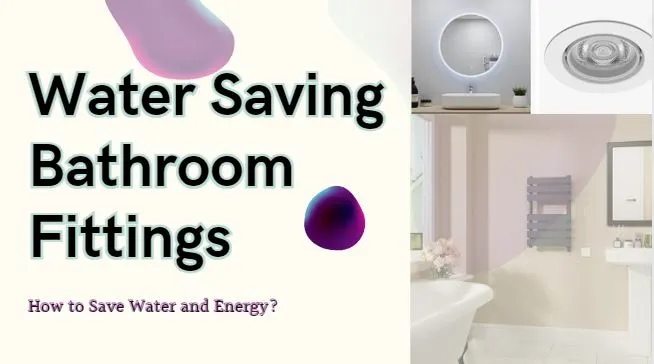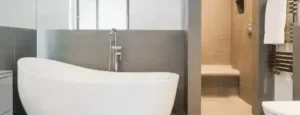Water and energy are essential resources for our daily lives, but they are also finite and costly. Saving water and energy in the bathroom can benefit the environment, reduce your bills, and improve your comfort. In this article, we will share some tips and tricks on how to choose and use bathroom fittings that can help you save water and energy without compromising on performance or quality.
Water and energy saving bathroom fittings

- Water saving bathroom fittings can reduce water consumption and energy usage by minimizing the use of heated water.
- Some examples of water saving bathroom fittings are taps and showers with flow regulators, dual flush toilets, and aerators.
- Energy saving bathroom fittings can reduce energy consumption and greenhouse gas emissions by using electricity or renewable sources instead of fossil fuels.
- Some examples of energy saving bathroom fittings are electric heated towel rails, LED lights, and solar water heaters.
- To save water and energy in the bathroom, you should also adopt some simple habits such as turning off the taps when not in use, taking shorter showers, and not overfilling the tub.
How to shop for water saving bathroom fittings
One of the easiest ways to save water and energy in the bathroom is to choose bathroom fittings that use water efficiently. Here are some features to look for when shopping for water saving bathroom fittings:
Taps and showers with flow regulators

Flow regulators are devices that limit the amount of water that flows through taps and showers. They can reduce water consumption by up to 50% without affecting the water pressure or the user experience. Flow regulators can be built-in or attached to existing taps and showers. Look for labeling that provides information about how much water and energy products are consumed, with the most efficient taps and showers delivering water at no more than 6 liters per minute.
Dual flush toilets

Dual flush toilets are toilets that have two buttons or levers that allow you to choose between a full flush and a half flush. A full flush uses more water to remove solid waste, while a half flush uses less water to remove liquid waste. By using the half flush option whenever possible, you can save up to 80 litres of water per day. Most of our toilets are dual flush and competitively priced, so you can save money on your water bills with every flush.
Aerators

Aerators are small devices that mix air with water to create a bubbly stream. They can be fitted to taps and shower heads to reduce water flow and increase water pressure. Aerators can save up to 30% of water and energy by reducing the amount of heated water needed. They are also inexpensive and easy to install, making them a simple and effective way to save water and energy in the bathroom.
How to shop for energy saving bathroom fittings
Another way to save water and energy in the bathroom is to choose bathroom fittings that use energy efficiently. Here are some features to look for when shopping for energy saving bathroom fittings:
Electrically heated towel rails

Electric heated towel rails are towel rails that operate using your home’s electricity supply instead of your boiler system. They can save energy and money by allowing you to switch them off when your bathroom is not in use, unlike traditional radiators that heat up the whole room. Electric towel rails also come with a thermostat that lets you control the temperature and avoid overheating.
LED lights

LED lights are lights that use light-emitting diodes (LEDs) instead of incandescent or fluorescent bulbs. They can save energy and money by using up to 80% less electricity and lasting up to 25 times longer than conventional bulbs. They also produce less heat and emit less carbon dioxide, making them more environmentally friendly. LED lights can be used for general lighting, task lighting, or accent lighting in the bathroom, creating a bright and cozy atmosphere.
Solar water heaters

Solar water heaters are water heaters that use solar energy to heat water instead of gas or electricity. They can save energy and money by using a renewable and free source of energy that does not generate any greenhouse gas emissions. Solar water heaters consist of solar collectors that absorb sunlight and transfer it to a storage tank that holds the heated water. Depending on the climate and the size of the system, solar water heaters can provide up to 100% of your hot water needs.
How to save water and energy in the bathroom with simple habits
In addition to choosing and using water saving and energy saving bathroom fittings, you can also save water and energy in the bathroom by adopting some simple habits. Here are some examples of habits that can make a difference:
- Turn off the taps when they are not in use. Water.org estimates that you use around 6 litres of water per minute brushing your teeth with the tap running. Turning your tap off between brushing your teeth or rinsing your hair will reduce your water consumption and potentially reduce your water bill.
- Take shorter showers. According to the Unified Water Label, if everybody took one minute off their shower time, we could save 7% of home water use and save energy too. Try to limit your shower time to no more than 10 minutes and use a timer or a shower radio to keep track of time.
- Don’t overfill your tub. If you just can’t resist the urge to fill your tub and sink into a world of relaxation after a tough week at work, you can still save water and money in the process. Don’t fill the tub up to the top – water is displaced when you get in, so reduce the amount of water you put in the bath and stop litres of water ending up down the overflow valve.
- Scrape dishes before washing. If you wash dishes in the bathroom sink, you can save water and energy by scraping them before washing, them instead of rinsing them. This will reduce the amount of water and detergent needed to clean them. You can also use a basin or a bowl to wash dishes, instead of letting the tap run continuously.
Conclusion
Saving water and energy in the bathroom is not only good for the environment but also for your wallet and your well-being. By choosing and using water saving and energy saving bathroom fittings and by adopting some simple habits, you can reduce your water and energy consumption and enjoy a more comfortable and efficient bathroom. Start today and see the difference for yourself!



